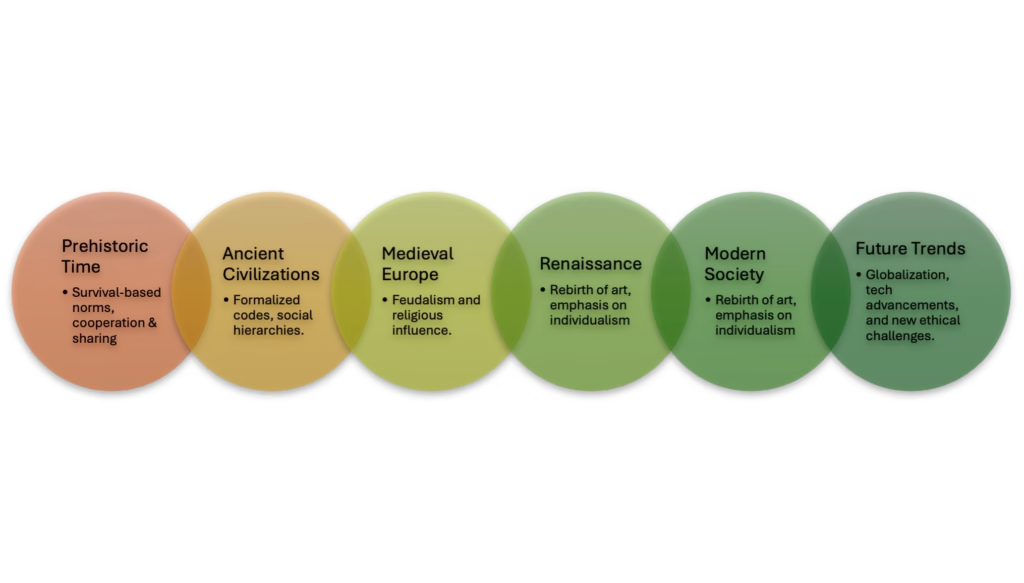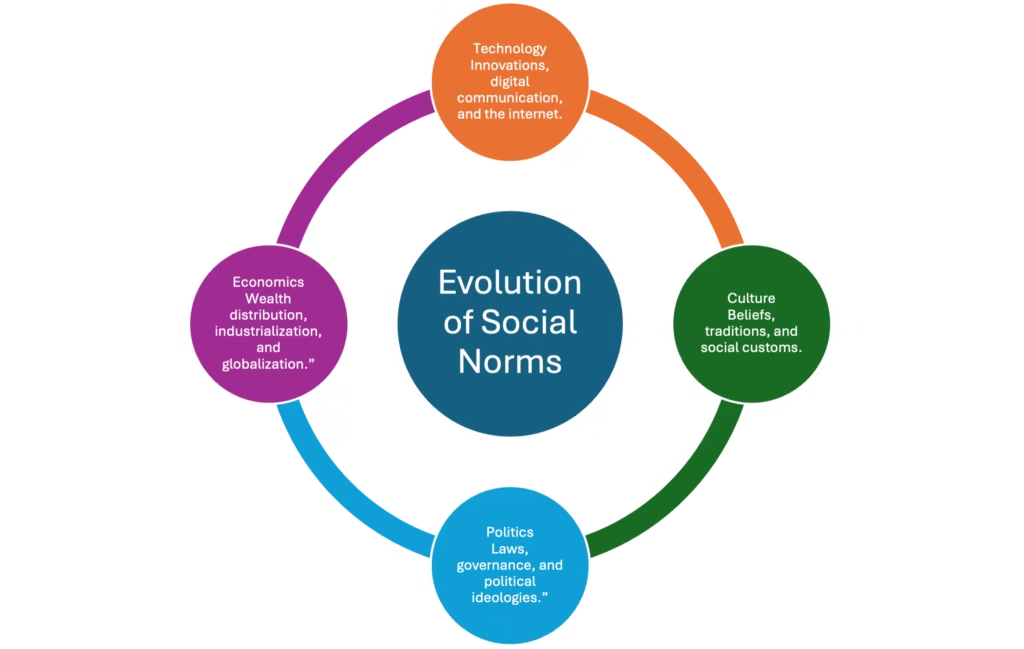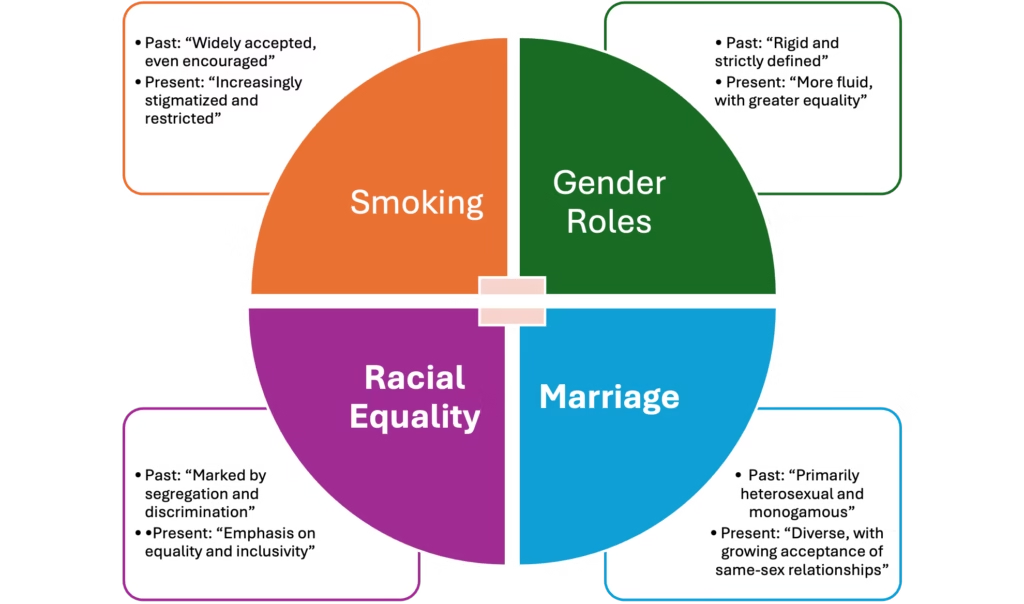“Society is not a mere sum of individuals, but a complex web of shared values and norms.”
— Inspired by Émile Durkheim
Social norms are the invisible threads that weave the fabric of our society. They are the shared expectations and unwritten rules that guide our interactions, shape our behaviours, and influence our beliefs. From the simple act of saying “please” and “thank you” to the complex courtship and marriage rituals, social norms are ubiquitous in human societies. But where did these norms come from, and how have they evolved?
This blog article will explore the evolution of social norms, tracing their development from our ancestors’ hunter-gatherer societies to the modern era’s intricate social structures. We will delve into the factors that have moulded these norms, including technology, culture, politics, and economics, and examine how they have impacted our actions and worldviews.

Fig1. Shows how social norms changed during different historical epochs
Factors Influencing the Evolution of Social Norms
“The only constant in life is change.”
— Heraclitus

Fig 2 Factors Affecting Social Norms
Before we further explore the history of social norms, let’s examine the forces that have shaped their evolution. These forces are multifaceted and interconnected, acting in concert to shape the invisible rules that govern our social lives.
Technology: Technological advancements have revolutionised the way we live, work, and interact with each other. From the invention of the wheel to the rise of the internet, technology has played a pivotal role in disseminating information, connecting people, and shaping social norms. Consider, for instance, how the printing press facilitated the spread of knowledge and ideas during the Renaissance or how social media has transformed communication and social interaction in the modern era.
Culture: Cultural values and beliefs are deeply intertwined with social norms. Different cultures have different expectations about behaviour, and these expectations are often rooted in long-standing traditions, religious beliefs, and social customs. For example, in some cultures, individualism is highly valued, while collectivism and community are emphasised in others. These cultural differences are reflected in social norms around family, marriage, work, and social interaction.
Politics: Political systems and ideologies powerfully influence social norms. Governments and political leaders often promote specific values and behaviours through laws, policies, and public discourse. For example, democratic societies usually emphasise individual rights and freedoms, while authoritarian regimes may impose stricter social controls and limitations on personal expression.
Economics: Economic factors, such as wealth distribution, social mobility, and resource access, can also shape social norms. In societies with high levels of economic inequality, there may be different norms around status, social hierarchy, and power distribution. Economic changes, such as industrialisation or globalisation, can also disrupt existing social norms and create new ones.
Internalisation of Norms: Social norms are not merely external rules that we follow out of fear of punishment or social pressure. They can also become internalised, meaning we adopt and follow them even when there is no external pressure to do so. This internalisation occurs through socialisation, education, and repeated exposure to social norms. As we grow up, we learn the norms of our society and internalise them as part of our moral compass.
Social Status and Identity: Our social status and group affiliations significantly affect how we perceive and adhere to social norms. We often conform to the norms of our social groups to gain acceptance, maintain our social standing, and avoid social exclusion. Social norms can also signal our identity and group membership. For example, how we dress, speak, and behave can convey our social status, ethnicity, or religious affiliation.
Mechanisms Supporting Normative Behavior: Social norms are reinforced through various mechanisms, including social pressure, signalling, and using benchmarks and reference points. Social pressure can be disapproval, ostracism, or punishment for violating social norms. Signalling refers to how we use our behaviour to convey information about ourselves to others. For example, we may dress acertaine way to signal our social status or profession. Benchmarks and reference points provide us with comparison standards and help us evaluate our behaviour toward others.
Social Norms in Prehistoric Times
Imagine a world without written laws, organised religion, or formal education. In prehistoric times, survival was paramount, and social norms were primarily geared towards ensuring the group’s well-being. Hunter-gatherer societies relied heavily on cooperation and sharing to thrive in challenging environments.
Within these societies, there was a division of labour, often with men taking on the responsibility of hunting and women focusing on gathering and childcare. However, it’s important to note that these roles were not always rigid. Flexibility and adaptability were key, and individuals often switched roles based on the specific needs and circumstances of the group.
Beyond the practicalities of survival, prehistoric social norms also emphasised the importance of kinship and social networks. Sharing resources, caring for infants, and fostering strong social bonds were not acts of kindness but essential strategies for survival and success in a world where collective strength was paramount.
Factors Influencing the Evolution of Social Norms
Social Norms in Ancient Civilizations
With a deeper understanding of the forces that shape social norms, let’s continue our journey through history. As societies transitioned from small, nomadic hunter-gatherer groups to larger, more settled communities, social norms evolved to reflect the changing needs and values of the people. In ancient civilisations, such as those in Mesopotamia, Greece, and Egypt, social norms became more formalised and codified.
In ancient Greece, for example, seating arrangements at social gatherings were carefully orchestrated to reflect social status and hierarchy. The seat to the host’s left was reserved for the guest of honour, symbolising trust, affection, and the importance of hospitality. In ancient Mesopotamia, showing the sole of your foot was considered a grave insult, as it was associated with filth and disrespect9. These examples illustrate how seemingly trivial social norms can reflect deeper cultural values and power dynamics. In ancient Greece, seating arrangements reinforced social hierarchies, while in Mesopotamia, the foot sole taboo highlighted the importance of cleanliness and respect in social interactions.
Ancient civilisations also witnessed the development of more complex social hierarchies and gender roles10. In many societies, women were subordinate to men and had limited rights and freedoms. However, there were exceptions, such as in ancient Egypt, where women had greater legal rights and could own property and businesses. This contrast between ancient Egypt and ancient Greece highlights the diversity of social norms in the ancient world and the influence of cultural and historical factors on gender roles.
Social Norms in Medieval Europe
Medieval Europe was a world of castles, knights, and chivalry, where social norms were deeply intertwined with religious beliefs and the feudal system11. Society was structured as a rigid hierarchy, with the nobility at the top, followed by the clergy, and then the peasantry. Social norms reinforced this hierarchy, dictating how individuals should interact with those of different social standings.
Manners and courtesy were highly valued in medieval Europe. Children were taught to be polite and respectful, and there was a strong emphasis on chivalry and proper behaviour, particularly among the nobility. Religious beliefs also played a significant role in shaping social norms, with the Church exerting considerable influence on moral values and social conduct11. The Church’s authority extended beyond spiritual matters, influencing legal rights, obligations, and social hierarchies. For example, different legal rights and punishments applied to other social classes, with nobles often receiving more lenient treatment than commoners11.
Social Norms in the Renaissance
The Renaissance, a period of great intellectual and artistic flourishing, brought significant cultural and social changes in Europe. While class hierarchies remained rigid, new opportunities for social mobility emerged, and individualism and humanism became increasingly important values.
Social norms in the Renaissance were influenced by the rediscovery of classical Greek and Roman texts, emphasising the importance of education, art, and philosophy. There was a greater focus on secularism, and art began to depict secular subjects and scenes from daily life, reflecting a shift away from the religious focus of the Middle Ages.
However, despite these changes, gender roles remained strictly defined, with women primarily confined to the domestic sphere15. Arranged marriages were the norm, and family life was centred on patriarchal structures, where the father or eldest male held authority over the household15.
Social Norms in Modern Society
“In our interconnected world, the power of social norms lies not only in tradition but in our ability to evolve.” Unknown
Modern society is a melting pot of cultures, ideas, and technologies, where social norms constantly evolve and are challenged. While some traditional norms persist, many have undergone significant transformations in recent times.
One of the most notable changes has been the shift in gender roles. Women increasingly participate in the workforce and public life, challenging traditional notions of femininity and masculinity. Social movements have played a crucial role in this transformation, advocating for greater equality and inclusivity18. However, it’s essential to acknowledge that gender inequality persists in many forms, and achieving true gender equality remains an ongoing challenge.
Technology has also profoundly impacted modern social norms, particularly in communication. Social media and online platforms have created new norms for interaction and self-expression, blurring the lines between public and private spheres16. The rapid adoption of email, text messaging, and social media platforms like Facebook is a prime example of how technology can drive swift and widespread changes in communication norms.
In addition to these changes, modern society is grappling with the concept of “pluralistic ignorance,” where individuals misperceive the prevalence of a norm. For example, people may overestimate the number of their peers who engage in risky bbehaviours such as binge drinking or drug use, leading them to conform to these perceived norms even if they don’t personally agree with them.
Furthermore, it’s important to distinguish between social norms and moral norms19. Social norms are primarily driven by social motivations, such as the desire to fit in or avoid social disapproval. On the other hand, ethical standards are based on personal beliefs about right and wrong, regardless of social expectations.
Examples of Social Norms That Have Changed Over Time
Social norms are not static entities; they constantly evolve in response to changing social, cultural, and technological landscapes. Here are some notable examples of social norms that have undergone significant transformations over time:

Fig 3 Examples of Social norms that changed through time
The Potential Future of Social Norms
Predicting the future is always challenging, but examining current trends and emerging technologies can provide insights into the potential future of social norms.
Increased globalisation: As the world becomes increasingly interconnected, globalisation will likely continue to influence social norms, leading to greater cultural exchange and new global norms. This could lead to both convergence and divergence of norms, as some norms become more universal while others remain specific to particular cultures or regions.
Technological advancements: Advancements in artificial intelligence, biotechnology, and other fields could profoundly impact social norms, raising new ethical and social questions. For example, how will social norms evolve in a world where robots and AI systems play an increasingly important role in our lives? How will we navigate privacy, autonomy, and social interaction issues in a technologically advanced society?
Environmental concerns: Growing awareness of environmental challenges like climate change and resource depletion may lead to new social norms around sustainability and responsible consumption4. These norms could involve changes in consumption habits, transportation choices, and attitudes toward environmental protection.
Social justice movements: Continued activism and advocacy for social justice could lead to further changes in social norms, promoting greater equality and inclusivity. This could involve challenging existing norms around race, gender, sexuality, and disability and creating a more just and equitable society for all.
Learning New Norms: Individuals must adapt to new social norms as societies and cultures evolve. This process of social norm learning involves three stages: pre-learning, reinforcement learning, and internalization5. In pre-learning, individuals gather information about social norms through observation and social interaction. In the reinforcement learning stage, they adjust their bbehaviourbased on social feedback and the consequences of their actions. Finally, in theinternalisationn stage, they adopt the new norms as their own and follow them even in the absence of external pressure.
Conclusion
Social norms have been integral to human societies throughout history, shaping our behaviours, beliefs, and interactions. From the survival-oriented norms of prehistoric times to the complex and diverse norms of modern society, these unwritten rules have guided our social evolution and influenced our understanding of the world.
Social norms evolve dynamically and continuously, driven by a complex interplay of technology, culture, politics, and economics. As we move forward, it’s essential to understand the forces shaping these norms and critically examine their impact on our lives. By studying the evolution of social norms, we can gain valuable insights into humanbehaviourr, societal development, and the challenges and opportunities that lie ahead.
Moreover, the evolution of social norms has implications for our understanding of morality, identity, and social change. As social norms evolve, so do our conceptions of right and wrong, our sense of belonging, and our ability to create a more just and equitable society. By embracing the dynamic nature of social norms, we can foster greater understanding, empathy, and cooperation in an increasingly interconnected world.
Works Cited
- How to survive and thrive: Labor and friendship among early humans, accessed January 29, 2025, https://blogs.bcm.edu/2021/04/02/how-to-survive-and-thrive-labor-and-friendship-among-early-humans/
- Gender roles in prehistory – Is the stereotype of men being hunters and women being child nurturers in prehistory generally true? : r/AskAnthropology – Reddit, accessed January 29, 2025, https://www.reddit.com/r/AskAnthropology/comments/qlfoim/gender_roles_in_prehistory_is_the_stereotype_of/
- Social Life – The Smithsonian’s Human Origins Program, accessed January 29, 2025, https://humanorigins.si.edu/human-characteristics/social-life
- Social norm change: drivers and consequences – PMC, accessed January 29, 2025, https://pmc.ncbi.nlm.nih.gov/articles/PMC10799731/
- How we learn social norms: a three-stage model for social … – Frontiers, accessed January 29, 2025, https://www.frontiersin.org/journals/psychology/articles/10.3389/fpsyg.2023.1153809/full
- www.econ2.jhu.edu, accessed January 29, 2025, http://www.econ2.jhu.edu/people/young/SocNormsOCT1.pdf
- Collective action and the evolution of social norm internalisation…, accessed January 29, 2025, https://www.pnas.org/doi/10.1073/pnas.1703857114
- The interplay of social identity and norm psychology in the evolution …, accessed January 29, 2025, https://royalsocietypublishing.org/doi/10.1098/rstb.2021.0412
- 10 Ancient Etiquette Rules You Never Knew Existed – Listverse, accessed January 29, 2025, https://listverse.com/2024/10/19/10-ancient-etiquette-rules-you-never-knew-existed/
- Women and Gender in the Ancient World – Schlager Group Inc, accessed January 29, 2025, https://www.schlagergroup.com/women-and-gender-in-the-ancient-world/
- Social Classes in Medieval Society | European History – 1000 to 1500 Class Notes, accessed January 29, 2025, https://library.fiveable.me/europe-1000-1500/unit-2/social-classes-medieval-society/study-guide/Ht7CHrQLAziF2dKz
- Minding your Manners in the Middle Ages – Medievalists.net, accessed January 29, 2025, https://www.medievalists.net/2021/08/manners-middle-ages/
- How did the Renaissance redefine cultural norms in Europe? – TutorChase, accessed January 29, 2025, https://www.tutorchase.com/answers/ib/history/how-did-the-renaissance-redefine-cultural-norms-in-europe
- library. Liveable.me, accessed January 29, 2025, https://library.fiveable.me/the-renaissance/unit-11#:~:text=Class%20hierarchies%20remained%20rigid%2C%20but,art%2C%20science%2C%20and%20philosophy.
- Renaissance Society: Class, Family, Gender – Fiveable, accessed January 29, 2025, https://library.fiveable.me/the-renaissance/unit-11
- Examples of Social Norms & Societal Standards in Sociology – Simply Psychology, accessed January 29, 2025, https://www.simplypsychology.org/social-norms-examples.html
- What are some examples of dramatic cultural change over history? : r/AskHistorians – Reddit, accessed January 29, 2025, https://www.reddit.com/r/AskHistorians/comments/xad40/what_are_some_examples_of_dramatic_cultural/
- prevention-collaborative.org, accessed January 29, 2025, https://prevention-collaborative.org/foundations/social-norms-change/#:~:text=Social%20norms%20do%20change%2C%20sometimes,in%20response%20to%20external%20events.
- DEFINING SOCIAL NORMS AND RELATED CONCEPTS November 2021 | Unicef, accessed January 29, 2025, https://www.unicef.org/media/111061/file/Social-norms-definitions-2021.pdf
- A research agenda for the study of social norm change | Philosophical Transactions of the Royal Society A: Mathematical, Physical and Engineering Sciences, accessed January 29, 2025, https://royalsocietypublishing.org/doi/10.1098/rsta.2020.0411
- Full article: Unraveling the Dark Side of Social Norms—Toward a Research Agenda on the Challenges of Social Norms in Health Communication, accessed January 29, 2025, https://www.tandfonline.com/doi/full/10.1080/10410236.2023.2296190

